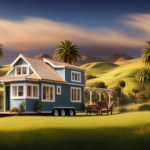Welcome to the enchanting world of tiny homes in the sunny region of Southern California! If you’ve ever dreamed of downsizing your living space, embracing a minimalist lifestyle, and incorporating eco-friendly habits, building a tiny home may be the perfect choice for you.
In this article, I will guide you through the step-by-step process of creating your very own tiny house in the beautiful landscape of Southern California.
First and foremost, it’s essential to research the zoning laws and building codes specific to this region. By understanding the regulations, you can ensure a smooth and legal construction process. Once you’ve done that, it’s time to determine your budget and explore financing options to make your dream a reality.
Choosing the right location is crucial, as Southern California offers a diverse range of landscapes and climates. From beachside retreats to mountain hideaways, the possibilities are endless. Once you’ve found your perfect spot, it’s time to design the layout and floor plan of your tiny house. Utilizing every inch of space efficiently is key.
Next, we delve into the world of sustainable and energy-efficient materials. From solar panels to rainwater collection systems, there are countless eco-friendly options to consider. Whether you decide to hire a contractor or take on the challenge yourself, it’s essential to ensure that your tiny house is built to code and meets all safety standards.
Once the construction is complete, it’s time to install plumbing, electrical, and HVAC systems. These essential features will ensure comfort and convenience in your tiny abode. Lastly, we’ll discuss how to decorate and furnish your tiny house, making it your own personal oasis.
By embracing the tiny house lifestyle, you’ll be joining a growing community of like-minded individuals who value simplicity, sustainability, and the freedom of living with less. So, let’s embark on this exciting journey together and create a tiny house that perfectly suits your needs and desires.
Welcome to the tiny house revolution in Southern California!
Key Takeaways
- Research zoning laws and building codes in Southern California to ensure compliance and avoid any legal issues during the construction of a tiny house.
- Determine your budget and financing options before starting the building process to avoid any financial constraints.
- Utilize sustainable and energy-efficient materials in the construction of your tiny house to promote environmental sustainability and reduce energy costs.
- Carefully plan the layout and placement of plumbing, electrical, and HVAC systems to ensure functionality and convenience in your tiny house.
Research Zoning Laws and Building Codes in Southern California
It’s crucial to research zoning laws and building codes in Southern California before starting to build a tiny house. Zoning restrictions vary from city to city, so it’s important to understand the specific regulations in the area where you plan to build.
Some cities may have restrictions on the minimum square footage or require specific setbacks from property lines. Additionally, you should also consider whether the city allows tiny house communities or if they require the house to be located on an individual lot.
To start your research, visit the city’s website and look for information on zoning and building codes. Many cities provide online resources and guides that outline the requirements for building a tiny house. You may also need to obtain permits and inspections throughout the construction process, so it’s important to familiarize yourself with the necessary procedures.
Once you have a good understanding of the zoning laws and building codes, you can then determine your budget and financing options. Understanding the costs associated with building a tiny house will help you plan your project and make informed decisions.
By researching zoning laws and building codes upfront, you can ensure that your tiny house meets all the necessary requirements and avoid any potential setbacks during the construction process.
Determine Your Budget and Financing Options
To determine your budget and financing options, you should first carefully assess your financial situation. Budget planning is crucial when building a tiny house in Southern California. Start by listing all your income sources and expenses to get a clear picture of your financial capabilities.
Consider factors like your current savings, monthly income, and any potential additional sources of funding.
Once you have a solid understanding of your financial situation, explore different loan options to finance your tiny house project. Some options include personal loans, home equity loans, or even crowdfunding platforms. Research various lenders and compare interest rates and terms to find the best fit for your needs.
In addition to loans, you may want to explore alternative financing options like grants or sponsorships. Some organizations offer financial assistance to individuals building sustainable or eco-friendly housing solutions.
Transitioning into the subsequent section about choosing the right location for your tiny house, it’s essential to consider your budget and financing options when selecting a location. The cost of land or rental fees in different areas of Southern California may vary significantly, so it’s important to keep your budget in mind while searching for the perfect spot for your tiny house.
Choose the Right Location for Your Tiny House
Once you’ve determined your budget and financing options, the next step is finding the perfect spot to plant your dream home, allowing you to immerse yourself in the serene beauty of Southern California.
When it comes to finding the best community for your tiny house, there are a few factors to consider. Begin by researching local zoning laws and regulations to ensure that tiny houses are permitted in your desired area. Some communities have specific guidelines and restrictions, so it’s crucial to do your due diligence.
Additionally, consider the amenities and services available in the surrounding area. Access to grocery stores, healthcare facilities, and recreational activities can greatly enhance your living experience.
Evaluating the environmental impact of your chosen location is also essential. Look for a spot that minimizes the impact on the environment and takes advantage of sustainable practices. Southern California is known for its beautiful landscapes, and finding a location that respects and preserves the natural surroundings is key. Consider factors such as water conservation, energy efficiency, and waste management.
As you finalize your location, keep in mind the transition into the subsequent section about designing your tiny house layout and floor plan. By carefully selecting the right spot for your tiny house, you’ll be one step closer to creating the perfect oasis in Southern California.
Design Your Tiny House Layout and Floor Plan
Take a moment to envision the layout and floor plan of your future cozy haven, customizing every nook and cranny to fit your unique needs and personal style. Designing your tiny house layout is an exciting process that requires careful consideration and creativity.
One of the most important aspects to focus on is maximizing storage in a tiny house. With limited square footage, it’s crucial to utilize every available space efficiently. Consider incorporating multifunctional furniture, such as a sofa that transforms into a bed or a dining table that doubles as a workspace. Built-in shelves, cabinets, and hidden storage compartments can also help keep your tiny house organized and clutter-free.
When planning your layout, think about the flow and functionality of each area. Create distinct zones for sleeping, cooking, dining, and relaxation. Use separators like curtains or sliding doors to provide privacy when needed. Additionally, consider the placement of windows and doors to maximize natural light and ventilation.
As you start designing your tiny house floor plan, keep in mind the transition to the subsequent section on selecting sustainable and energy-efficient materials. By carefully choosing materials that are eco-friendly and energy-efficient, you can reduce your environmental impact and create a more sustainable living space.
Select Sustainable and Energy-Efficient Materials
Choosing sustainable and energy-efficient materials for your tiny house not only helps reduce your environmental impact but can also save you money in the long run. Did you know that using energy-efficient windows can reduce heating and cooling costs by up to 25%? When designing and constructing your tiny house, it’s important to consider sustainable building materials and energy-efficient construction techniques.
One key aspect of sustainable building materials is using renewable resources. For example, you can opt for bamboo flooring instead of hardwood, as bamboo grows much faster and is considered a more sustainable option. Additionally, using recycled materials such as reclaimed wood or recycled metal can help reduce waste and minimize the extraction of raw materials from the environment.
Energy-efficient construction techniques involve using materials that have high insulation properties. This includes using insulation made from recycled materials or natural fibers like wool or cotton. Additionally, selecting energy-efficient appliances and fixtures can further reduce your energy consumption.
Incorporating sustainable and energy-efficient materials into your tiny house not only benefits the environment but also improves the overall comfort and efficiency of your home. By reducing your energy usage and choosing materials with a lower environmental impact, you can create a more sustainable living space.
With these considerations in mind, it’s time to move on to the next step and obtain the necessary permits and licenses for your tiny house construction project.
Obtain Necessary Permits and Licenses
Transitioning from selecting sustainable and energy-efficient materials, the next crucial step in building a tiny house in Southern California is to obtain necessary permits and licenses. This process ensures that you comply with local building codes and regulations, ensuring the safety and legality of your project.
To simplify this task, I have prepared a table below that outlines the key permits and licenses you may need to acquire before starting construction.
| Permit/License | Purpose | Issuing Authority |
|---|---|---|
| Building Permit | Allows for the construction of the tiny house | Local Building Department |
| Zoning Permit | Ensures compliance with zoning regulations | Local Zoning Department |
| Electrical Permit | Authorizes electrical work and connections | Local Electrical Authority |
| Plumbing Permit | Required for plumbing installations | Local Plumbing Authority |
The licensing process may vary depending on your location, so it is essential to contact the respective authorities to understand the specific requirements and procedures. This step may involve submitting detailed plans, paying fees, and scheduling inspections. Remember, obtaining permits and licenses may take time, so it’s crucial to start this process as early as possible to avoid delays.
Once you have obtained the necessary permits and licenses, you can move forward with the exciting decision of whether to hire a contractor or build your tiny house yourself.
Hire a Contractor or Build Your Tiny House Yourself
Once you’ve secured the necessary permits and licenses, it’s time to decide whether you want to bring in a skilled contractor or embark on the rewarding journey of building your own dream home.
Hiring a contractor has its pros and cons. On the positive side, a contractor brings expertise and experience to the table. They have the knowledge and skills to ensure that your tiny house is built to code and meets all safety requirements. They can also help you navigate the complex world of construction, from sourcing materials to coordinating subcontractors. However, hiring a contractor can be expensive, and it may eat into your tight budget.
On the other hand, building a tiny house on a tight budget may require you to take on the role of the general contractor yourself. This means you’ll be responsible for managing the project, sourcing materials, and coordinating the various aspects of construction. While this can be a challenging task, it also allows you to have more control over the process and potentially save money. You can choose to do some of the work yourself or hire individual tradespeople for specific tasks. Just keep in mind that building a tiny house requires a wide range of skills, so be prepared to invest time and effort into learning new things.
As you consider whether to hire a contractor or take on the project yourself, it’s important to weigh the pros and cons and consider your budget and personal preferences. Whichever path you choose, building a tiny house is an exciting and fulfilling endeavor that allows you to create a space that perfectly suits your needs and lifestyle.
Moving on to the next step of your tiny house construction, it’s important to consider the installation of plumbing, electrical, and HVAC systems.
Install Plumbing, Electrical, and HVAC Systems
Now that you’ve decided on your construction approach, it’s time to tackle the crucial step of installing the plumbing, electrical, and HVAC systems in your dream home. Understanding the construction process and ensuring safety and compliance are key factors in this stage.
-
Plan your layout: Before diving into the installation, carefully plan the placement of plumbing, electrical, and HVAC systems. Consider the size and layout of your tiny house to optimize space and functionality.
-
Plumbing installation: Start by installing the water supply system, including pipes, faucets, and fixtures. Don’t forget to add insulation to protect pipes from freezing during colder months. Next, install a drainage system to efficiently remove waste water. If you’re unsure about plumbing codes and regulations, consult a professional to ensure compliance.
-
Electrical wiring: Hiring a licensed electrician is highly recommended for this task. They’ll help you design and install a safe and efficient electrical system. Consider the location of power outlets, light fixtures, and switches to maximize convenience and functionality.
-
HVAC system: Depending on your climate and personal preferences, choose an HVAC system that suits your needs. Whether it’s a mini-split system or a traditional central AC unit, proper installation is crucial for optimal comfort.
Now that your plumbing, electrical, and HVAC systems are in place, it’s time to move on to the exciting part of decorating and furnishing your tiny house.
[Subsequent section: ‘Decorate and Furnish Your Tiny House’]Decorate and Furnish Your Tiny House
Get ready to turn your tiny space into a cozy and stylish haven by adding personal touches and carefully selecting furniture and decor. When it comes to decorating and furnishing your tiny house, it’s important to make the most of every square inch.
Tiny house storage solutions and creative space-saving ideas are key to maximizing the functionality of your small home. One great way to optimize storage in a tiny house is by utilizing multi-functional furniture. Look for pieces that can serve multiple purposes, such as a sofa that can also be converted into a bed or a coffee table with hidden storage compartments. Additionally, consider using vertical space by installing shelves or utilizing wall-mounted storage solutions.
To create a sense of openness and airiness in your tiny house, opt for light-colored furniture and decor. This will make the space feel larger and more inviting. Mirrors can also be strategically placed to reflect light and create the illusion of a bigger space.
When selecting decor, choose items that are meaningful to you and reflect your personal style. Remember, less is more in a tiny house, so be selective with your choices. Incorporate elements of nature, such as plants or natural materials, to bring a sense of tranquility to your space.
By incorporating these tiny house storage solutions and creative space-saving ideas, you can transform your tiny house into a functional and stylish sanctuary. Embrace the tiny house lifestyle and enjoy your new home, where every inch is utilized efficiently, and your personal style shines through.
Embrace the Tiny House Lifestyle and Enjoy Your New Home
Embrace the cozy and stylish haven of your new tiny home and revel in the freedom of the minimalist lifestyle. Living in a tiny house allows you to truly embrace minimalist living and experience the numerous benefits of downsizing.
One of the key advantages of living in a tiny house is the reduced cost of living. With a smaller space, you’ll have lower utility bills and fewer maintenance expenses. This allows you to save money or allocate it towards other priorities, such as travel or hobbies.
Another benefit of downsizing to a tiny house is the ability to live a more environmentally friendly lifestyle. With less square footage to heat, cool, and furnish, you’ll consume fewer resources and reduce your carbon footprint. Additionally, living in a tiny house encourages you to adopt a more sustainable mindset, as you’ll be more conscious of your consumption habits and strive to live a simpler, less wasteful life.
Living in a tiny house also promotes a sense of freedom and flexibility. With less space to clean and maintain, you’ll have more time and energy to focus on the things that truly matter to you. You’ll be able to spend more time outdoors, exploring the beautiful surroundings of Southern California, and pursuing your passions. Additionally, the smaller footprint of a tiny house allows for more flexibility in terms of location. You can easily relocate your home to different areas, whether it’s to be closer to nature or to explore new communities.
Embracing the tiny house lifestyle in Southern California offers numerous benefits, including cost savings, environmental sustainability, and a greater sense of freedom. By downsizing and embracing minimalist living, you can create a cozy and stylish haven that allows you to fully enjoy your new home.
Frequently Asked Questions
How long does it typically take to obtain the necessary permits and licenses for building a tiny house in Southern California?
Obtaining permits and licenses for building a tiny house in Southern California can be a long and arduous process. It’s like navigating a maze, where every turn leads to more paperwork and waiting.
From my experience, it typically takes several months to obtain all the necessary approvals. The timeline for approval can vary depending on factors such as the location, size, and design of the tiny house.
Patience and persistence are key in this bureaucratic endeavor.
Are there any specific restrictions or regulations regarding the size or height of a tiny house in Southern California?
There are indeed specific restrictions and regulations regarding the size and height of a tiny house in Southern California. These rules are in place to ensure the safety and compliance of structures.
The height of a tiny house is typically limited to 13.5 feet, while the size restrictions vary depending on the specific zoning regulations of the area.
It’s crucial to consult local building codes and ordinances to ensure compliance with these specific restrictions and height regulations.
What are some common challenges people face when building a tiny house in Southern California, and how can they be overcome?
Common challenges when building a tiny house in Southern California include finding suitable land, obtaining permits, and dealing with zoning regulations. Overcoming these challenges requires careful research and planning.
It is crucial to identify land that allows for tiny house construction and meets all necessary requirements. Additionally, navigating the permit process can be complex, so consulting with local authorities and professionals can help ensure compliance.
Adhering to zoning regulations is essential to avoid legal issues and fines.
Are there any financial incentives or tax breaks available for building a tiny house in Southern California?
There are indeed financial incentives and tax breaks available for building a tiny house in Southern California. The state offers various programs and incentives to encourage sustainable housing, including tax credits and grants for energy-efficient construction.
Additionally, some cities may provide additional incentives such as reduced permit fees or property tax exemptions. It’s important to research and consult with local authorities to fully understand the specific financial benefits and requirements for building a tiny house in Southern California.
Can I legally park my tiny house on my own property in Southern California, or do I need to find a designated tiny house community or RV park?
Legally parking my tiny house in Southern California is like finding a unicorn in a parking lot. The parking regulations and zoning laws here can make your head spin. In most cases, you’ll need to find a designated tiny house community or an RV park that allows tiny houses.
However, it’s always a good idea to check with local authorities and research specific zoning laws in your area to avoid any legal hassles.
Conclusion
Well, after months of research, planning, and hard work, I finally have my very own tiny house in Southern California. It’s ironic how something so small can bring so much joy and freedom.
As I sit here in my cozy living room, surrounded by sustainable and energy-efficient materials, I can’t help but smile. My tiny house may be small in size, but it’s big on character and charm.
It’s a place where I can truly embrace the simplicity of life and enjoy the breathtaking views of Southern California. It’s my own little piece of paradise.
Hi, I’m Emma. I’m the Editor in Chief of Tiny House 43, a blog all about tiny houses. While tree houses are often associated with childhood, they can be the perfect adult retreat. They offer a cozy space to relax and unwind, surrounded by nature. And since they’re typically built on stilts or raised platforms, they offer stunning views that traditional homes simply can’t match. If you’re looking for a unique and romantic getaway, a tree house tiny house might just be the perfect option.
















